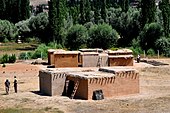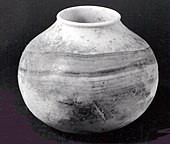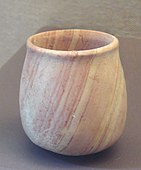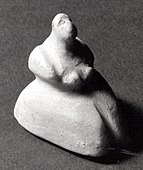History of Mesopotamia
This article has multiple issues. Please help improve it or discuss these issues on the talk page. (Learn how and when to remove these template messages)
|

The history of
Short outline of Mesopotamia

Mesopotamia (
Later and in the broader sense, the historical region included not only the area of present-day Iraq, but also parts of present-day Iran, Syria and Turkey.[2][3][4][5][6][7] The neighbouring steppes to the west of the Euphrates and the western part of the Zagros Mountains are also often included under the wider term Mesopotamia.[8][9][10] A further distinction is usually made between Upper or Northern Mesopotamia and Lower or Southern Mesopotamia.[11]
Chronology and periodization
Two types of chronologies can be distinguished: a
By combining absolute and relative dating methods, a chronological framework has been built for Mesopotamia that still incorporates many uncertainties but that also continues to be refined.
The chronology for much of the third and second millennia BC is subject to much debate. Based on different estimates for the length of periods for which still very few historical documents are available, so-called Ultra-long, Long,
Prehistory
Pre-Pottery Neolithic period

The early Neolithic human occupation of Mesopotamia is, like the previous Epipaleolithic period, confined to the foothill zones of the Taurus and Zagros Mountains and the upper reaches of the Tigris and Euphrates valleys. The Pre-Pottery Neolithic A (PPNA) period (10,000–8,700 BC) saw the introduction of agriculture, while the oldest evidence for animal domestication dates to the transition from the PPNA to the Pre-Pottery Neolithic B (PPNB, 8700–6800 BC) at the end of the 9th millennium BC. This transition has been documented at sites like Abu Hureyra and Mureybet, which continued to be occupied from the Natufian well into the PPNB.[23][24] The so-far earliest monumental sculptures and circular stone buildings from Göbekli Tepe in southeastern Turkey date to the PPNA/Early PPNB and represent, according to the excavator, the communal efforts of a large community of hunter-gatherers.[25][26]
-
Inside the Shanidar Cave, where the remains of eight adults and two infant Neanderthals, dating from around 65,000–35,000 years ago were found, northern Iraq.
-
Skeletal remains of Shanidar II, c. 60,000 to 45,000 BCE. Iraq Museum
-
Reconstitution of housing in Aşıklı Höyük, Upper Mesopotamia, modern Turkey.
-
Jar in calcite alabaster, Syria, late 8th millennium BC.
-
Mace-head, late 8th millennium BC.
-
Alabaster pot Mid-Euphrates region, 6500 BC, Louvre Museum
-
Alabaster pot, Mid-Euphrates region, 6500 BC, Louvre Museum
-
Female statuette, 8th millennium BC, Syria.
Chalcolithic period
The Fertile Crescent was inhabited by several distinct, flourishing cultures between the end of the last ice age (c. 10,000 BC) and the beginning of history. One of the oldest known Neolithic sites in Mesopotamia is Jarmo, settled around 7000 BC and broadly contemporary with Jericho (in the Levant) and Çatalhöyük (in Anatolia). It as well as other early Neolithic sites, such as Samarra and Tell Halaf were in northern Mesopotamia; later settlements in southern Mesopotamia required complicated irrigation methods. The first of these was Eridu, settled during the Ubaid period culture by farmers who brought with them the Samarran culture from the north.
Halaf culture (Northwestern Mesopotamia)
Pottery was decorated with abstract geometric patterns and ornaments, especially in the Halaf culture, also known for its clay fertility figurines, painted with lines. Clay was all around and the main material; often modelled figures were painted with black decoration. Carefully crafted and dyed pots, especially jugs and bowls, were traded. As dyes, iron oxide containing clays were diluted in different degrees or various minerals were mixed to produce different colours.
Hassuna culture (Northern Mesopotamia)
The Hassuna culture is a Neolithic archaeological culture in northern Mesopotamia dating to the early sixth millennium BC. It is named after the type site of Tell Hassuna in Iraq. Other sites where Hassuna material has been found include Tell Shemshara.
Samarra culture (Central Mesopotamia)

The Samarra culture is a Chalcolithic archaeological culture in northern Mesopotamia that is roughly dated to 5500–4800 BCE. It partially overlaps with the Hassuna and early Ubaid.
Ubaid culture (Southern Mesopotamia)
The Ubaid period (c. 6500–3800 BC)[27] is a prehistoric period of Mesopotamia. The name derives from Tell al-'Ubaid in Southern Mesopotamia, where the earliest large excavation of Ubaid period material was conducted initially by Henry Hall and later by Leonard Woolley.[28]
In South Mesopotamia the period is the earliest known period on the alluvial plain although it is likely earlier periods exist obscured under the alluvium.[29] In the south it has a very long duration between about 6500 and 3800 BC when it is replaced by the Uruk period.[30]
Northern expansion of Ubaid culture
In North Mesopotamia the period runs only between about 5300 and 4300 BC.
Uruk period
Named after the Sumerian city of Uruk, this period saw the emergence of urban life in Mesopotamia.
Sumerian civilization took form in the Uruk period (4th millennium BC), continuing into the Jemdet Nasr and Early Dynastic periods
.[38]
The late Uruk period (34th to 32nd centuries) saw the gradual emergence of the
Third millennium BC
Jemdet Nasr period

The Jemdet Nasr period, named after the type-site Jemdet Nasr, is generally dated to 3100–2900 BC.[39] It was first distinguished on the basis of distinctive painted monochrome and polychrome pottery with geometric and figurative designs.[40] The cuneiform writing system that had been developed during the preceding Uruk period was further refined. While the language in which these tablets were written cannot be identified with certainty for this period, it is thought to be Sumerian. The texts deal with administrative matters like the rationing of foodstuffs or lists of objects or animals.[41] Settlements during this period were highly organized around a central building that controlled all aspects of society. The economy focused on local agricultural production and sheep-and-goat pastoralism. The homogeneity of the Jemdet Nasr period across a large area of southern Mesopotamia indicates intensive contacts and trade between settlements. This is strengthened by the find of a sealing at Jemdet Nasr that lists a number of cities that can be identified, including Ur, Uruk and Larsa.[42]
Early Dynastic period

The entire Early Dynastic period is generally dated to 2900–2350 BC according to the
By the 3rd millennium BC, these

The chronology of this era is particularly uncertain due to difficulties in our understanding of the text, our understanding of the material culture of the Early Dynastic period and a general lack of radiocarbon dates for sites in Iraq. Also, the multitude of city-states makes for a confusing situation, as each has its own history. In the past, the Sumerian King List was considered to be an important historical source, but recent scholarship has dismissed the utility of this text up to the point that it should not be used at all for the reconstruction of Early Dynastic political history.[45]

Akkadian gradually replaced Sumerian as the spoken language of Mesopotamia somewhere around the turn of the 3rd and the 2nd millennium BC (the exact dating being a matter of debate),[46] but Sumerian continued to be used as a sacred, ceremonial, literary and scientific language in Mesopotamia until the 1st century AD.
Akkadian Empire
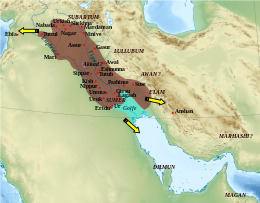
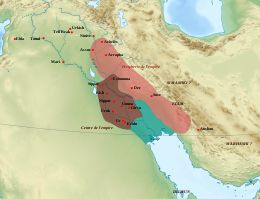
The Akkadian period is generally dated to 2350–2170 BC according to the
The Akkadian Empire lost power after the reign of Naram-Sin, and eventually was invaded by the
Ur III period
Eventually the Guti were overthrown by Utu-hengal of Uruk, and the various city-states again vied for power. Power over the area finally went to the city-state of Ur, when Ur-Nammu founded the Ur III Empire (2112–2004 BC) and conquered the Sumerian region. Under his son Shulgi, state control over industry reached a level never again seen in the region. Shulgi may have devised the Code of Ur-Nammu, one of the earliest known law codes (three centuries before the more famous Code of Hammurabi). Around 2000 BC, the power of Ur waned, and the Amorites came to occupy much of the area, although it was Sumer's long-standing rivals to the east, the Elamites, who finally overthrew Ur. In the north, Assyria remained free of Amorite control until the very end of the 19th century BC. This marked the end of city-states ruling empires in Mesopotamia, and the end of Sumerian dominance, but the succeeding rulers adopted much of Sumerian civilization as their own.
Second millennium BC
Old Assyrian Period
Of the early history of the kingdom of Assyria, little is positively known. The
Isin-Larsa, Old Babylonian and Shamshi-Adad I
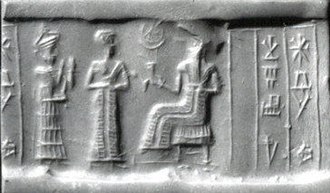
The next two centuries or so, called the
Unlike the south of Mesopotamia, the native Akkadian kings of Assyria repelled Amorite advances during the 20th and 19th centuries BC. However this changed in 1813 BC when an Amorite king named
Middle Assyrian Period and Empire
The Middle Assyrian period begins c. 1720 BC with the ejection of Amorites and Babylonians from Assyria by a king called
.Kassite dynasty of Babylon
Although the Hittites overthrew Babylon, another people, the
Hurrians

The Hurrians were a people who settled in northwestern Mesopotamia and southeast Anatolia in 1600 BC. By 1450 BC they established a medium-sized empire under a Mitanni ruling class, and temporarily made tributary vassals out of kings in the west, making them a major threat for the Pharaoh in Egypt until their overthrow by Assyria. The Hurrian language is related to the later Urartian, but there is no conclusive evidence these two languages are related to any others.
Hittites
By 1300 BC the Hurrians had been reduced to their homelands in
Bronze Age collapse
Records from the 12th and 11th centuries BC are sparse in Babylonia, which had been overrun with new
First millennium BC
Neo-Assyrian Empire

The Neo-Assyrian Empire is usually considered to have begun with the accession of Adad-nirari II, in 911 BC, lasting until the fall of Nineveh at the hands of the Babylonians, Medes, Scythians and Cimmerians in 612 BC. The empire was the largest and most powerful the world had yet seen. At its height Assyria conquered the
Neo-Babylonian Empire
The Neo-Babylonian Empire or Second Babylonian Empire was a period of Mesopotamian history which began in 620 BC and ended in 539 BC. During the preceding three centuries, Babylonia had been ruled by their fellow
Classical Antiquity to Late Antiquity
After the death of
For two centuries of Achaemenid rule both Assyria and Babylonia flourished,
- Classical Antiquity
- Median and Babylonian Assyria (605 to 549 BC)
- Persian Babylonia,
- Achaemenid Assyria (6th to 4th centuries BC)
- Seleucid Mesopotamia (4th to 2nd centuries BC)
- Parthian Asuristan (Assyria) (2nd century BC to 3rd century AD)
- Osroene (2nd century BC to 3rd century AD)
- Adiabene (1st to 2nd centuries AD)
- Roman Mesopotamia (2nd to 7th centuries AD), Roman Assyria (2nd century AD)
- Late Antiquity
See also
- Assyria
- Babylonia
- Cradle of civilization
- History of institutions in Mesopotamia
- History of Iraq
- Levantine Iron Age Anomaly
- Music of Mesopotamia
- Sumer
References
Citations
- ^ Finkelstein 1962, p. 73
- ^ "history of Mesopotamia | Definition, Civilization, Summary, Agriculture, & Facts | Britannica". www.britannica.com. Retrieved 2022-04-30.
- ^ "How Mesopotamia Became Iraq (and Why It Matters)". Los Angeles Times. 1990-09-02. Retrieved 2022-04-30.
- ^ Wood, Michael (2010-11-10). "The Ancient World | Mesopotamia". the Guardian. Retrieved 2022-04-30.
- S2CID 224788984.
- ^ Miquel et al. 2011.
- ^ a b Foster & Polinger Foster 2009, p. 6
- ^ a b Canard 2011
- ^ Wilkinson 2000, pp. 222–223
- ^ Matthews 2003, p. 5
- ^ a b Miquel et al. 2011
- ^ Bahrani 1998
- ^ a b Matthews 2003, pp. 65–66
- ^ a b c van de Mieroop 2007, p. 4
- ^ van de Mieroop 2007, p. 3
- ^ Brinkman 1977
- ^ Gasche et al. 1998
- ^ Kuhrt 1997, p. 12
- ^ Potts 1999, p. xxix
- ^ Akkermans & Schwartz 2003, p. 13
- ^ Sagona & Zimansky 2009, p. 251
- ^ Manning et al. 2001
- ^ Moore, Hillman & Legge 2000
- ^ Akkermans & Schwartz 2003
- ^ Schmidt 2003
- ^ Banning 2011
- ISBN 978-1-885923-66-0p. 2; "Radiometric data suggest that the whole Southern Mesopotamian Ubaid period, including Ubaid 0 and 5, is of immense duration, spanning nearly three millennia from about 6500 to 3800 B.C."
- ^ Hall, Henry R. and Woolley, C. Leonard. 1927. Al-'Ubaid. Ur Excavations 1. Oxford: Oxford University Press.
- ^ Adams, Robert MCC. and Wright, Henry T. 1989. 'Concluding Remarks' in Henrickson, Elizabeth and Thuesen, Ingolf (eds.) Upon This Foundation - The ’Ubaid Reconsidered. Copenhagen: Museum Tusculanum Press. pp. 451-456.
- ^ a b Carter, Robert A. and Philip, Graham. 2010. 'Deconstructing the Ubaid' in Carter, Robert A. and Philip, Graham (eds.) Beyond the Ubaid: Transformation and Integration in the Late Prehistoric Societies of the Middle East. Chicago: The Oriental Institute of the University of Chicago. p. 2.
- ^ "Site officiel du musée du Louvre". cartelfr.louvre.fr.
- ISBN 9780931464966.
- ^ "Site officiel du musée du Louvre". cartelfr.louvre.fr.
- ^ ISBN 9781405137232.
- ^ ISBN 9780141938257.
- ^ ISBN 9780521796668.
- ISBN 9780826332547.
- ^ Crawford 2004, p. 75
- ^ Pollock 1999, p. 2
- ^ Matthews 2002, pp. 20–21
- ^ Woods 2010, pp. 36–45
- ^ Matthews 2002, pp. 33–37
- ^ a b Pruß 2004
- ^ Woolley 1965, p. 9
- ^ Marchesi, Gianni (2010). "The Sumerian King List and the Early History of Mesopotamia". M. G. Biga - M. Liverani (Eds.), ana turri gimilli: Studi dedicati al Padre Werner R. Mayer, S. J., da amici e allievi (Vicino Oriente - Quaderno 5; Roma): 231–248.
- ^ Woods 2006
- ^ "Ancient Irrigation". Archived from the original on 2019-05-03. Retrieved 2013-04-23.
- ^ Saggs, The Might, 24.
- ^ Potts 1999, p. 318.
Notes
Bibliography
- Akkermans, Peter M.M.G.; Schwartz, Glenn M. (2003). The Archaeology of Syria. From Complex Hunter-Gatherers to Early Urban Societies (ca. 16,000–300 BC). Cambridge: Cambridge University Press. ISBN 0-521-79666-0.
- Bahrani, Z. (1998). "Conjuring Mesopotamia: Imaginative Geography a World Past". In Meskell, L. (ed.). Archaeology under Fire: Nationalism, Politics and Heritage in the Eastern Mediterranean and Middle East. London: Routledge. pp. 159–174. ISBN 978-0-415-19655-0.
- Banning, E.B. (2011). "So Fair a House. Göbekli Tepe and the Identification of Temples in the Pre-Pottery Neolithic of the Near East". Current Anthropology. 52 (5): 619–660. S2CID 161719608.
- OCLC 395172. Archived from the original(PDF) on 2012-10-07. Retrieved 2011-02-26.
- Brinkman, J.A. (1977). "Appendix: Mesopotamian Chronology of the Historical Period". In ISBN 0-226-63186-9.
- Canard, M. (2011). "al-ḎJazīra, Ḏjazīrat Aḳūr or Iḳlīm Aḳūr". In Bearman, P.; Bianquis, Th.; OCLC 624382576.
- ISBN 9780521533386.
- ISBN 978-0-19-953222-3.
- Finkelstein, J.J. (1962). "Mesopotamia". Journal of Near Eastern Studies. 21 (2): 73–92. S2CID 222432558.
- Foster, Benjamin R.; Polinger Foster, Karen (2009). Civilizations of Ancient Iraq. Princeton: Princeton University Press. ISBN 978-0-691-13722-3.
- Gasche, H.; Armstrong, J.A.; Cole, S.W.; Gurzadyan, V.G. (1998). Dating the Fall of Babylon: a Reappraisal of Second-Millennium Chronology. Chicago: University of Ghent/Oriental Institute of the University of Chicago. ISBN 1-885923-10-4.
- Hunt, Will (2010). Arbil, Iraq Discovery Could be Earliest Evidence of Humans in the Near East. Heritage Key. Retrieved 4 August 2010.
- Kozłowski, Stefan Karol (1998). "M'lefaat: Early Neolithic Site in Northern Irak". Cahiers de l'Euphrate. 8: 179–273. OCLC 468390039.
- Kuhrt, A. (1997). Ancient Near East c. 3000–330 BC. London: Routledge. ISBN 0-415-16763-9.
- Manning, S.W.; Kromer, B.; Kuniholm, P.I.; Newton, M.W. (2001). "Anatolian Tree Rings and a New Chronology for the East Mediterranean Bronze-Iron Ages". Science. 294 (5551): 2532–2535. S2CID 33497945.
- Matthews, Roger (2002). Secrets of the Dark Mound: Jemdet Nasr 1926–1928. Iraq Archaeological Reports. Vol. 6. Warminster: BSAI. ISBN 0-85668-735-9.
- Matthews, Roger (2003). The Archaeology of Mesopotamia: Theories and Approaches. Approaching the past. Milton Square: Routledge. ISBN 0-415-25317-9.
- Miquel, A.; Brice, W.C.; Sourdel, D.; Aubin, J.; Holt, P.M.; Kelidar, A.; Blanc, H.; MacKenzie, D.N.; Pellat, Ch. (2011). "ʿIrāḳ". In Bearman, P.; Bianquis, Th.; OCLC 624382576.
- Mohammadifar, Yaghoub; Motarjem, Abbass (2008). "Settlement Continuity in Kurdistan". Antiquity. 82 (317). ISSN 0003-598X.
- Moore, A.M.T.; Hillman, G.C.; Legge, A.J. (2000). Village on the Euphrates: From Foraging to Farming at Abu Hureyra. Oxford: Oxford University Press. ISBN 0-19-510807-8.
- Muhesen, Sultan (2002). "The Earliest Paleolithic Occupation in Syria". In Akazawa, Takeru; Aoki, Kenichi; ISBN 0-306-47153-1.
- Pollock, Susan (1999). Ancient Mesopotamia: The Eden That Never Was. Case Studies in Early Societies. Cambridge: Cambridge University Press. ISBN 978-0-521-57568-3.
- Potts, D.T. (1999). The Archaeology of Elam. Cambridge: Cambridge University Press. ISBN 0-521-56496-4.
- Pruß, Alexander (2004), "Remarks on the Chronological Periods", in Lebeau, Marc; Sauvage, Martin (eds.), Atlas of Preclassical Upper Mesopotamia, Subartu, vol. 13, pp. 7–21, ISBN 2503991203
- Sagona, A.; Zimansky, P. (2009). Ancient Turkey. London: Routledge. ISBN 978-0-415-28916-0.
- Schmid, P.; Rentzel, Ph.; Renault-Miskovsky, J.; Muhesen, Sultan; Morel, Ph.; Le Tensorer, Jean Marie; Jagher, R. (1997). "Découvertes de Restes Humains dans les Niveaux Acheuléens de Nadaouiyeh Aïn Askar (El Kowm, Syrie Centrale)". Paléorient. 23 (1): 87–93. .
- Schmidt, Klaus (2003). "The 2003 Campaign at Göbekli Tepe (Southeastern Turkey)" (PDF). Neo-Lithics. 2/03: 3–8. ISSN 1434-6990. Retrieved 21 October 2011.
- ISBN 0-19-506512-3.
- ISBN 978-0-631-22552-2.
- Wilkinson, Tony J. (2000). "Regional Approaches to Mesopotamian Archaeology: the Contribution of Archaeological Surveys". Journal of Archaeological Research. 8 (3): 219–267. S2CID 140771958.
- Woods, Christopher (2006). "Bilingualism, Scribal Learning, and the Death of Sumerian" (PDF). In Sanders, S.L. (ed.). Margins of Writing, Origins of Culture. Chicago: University of Chicago Press. pp. 91–120. Archived from the original (PDF) on 2013-04-29. Retrieved 2010-03-29.
- Woods, Christopher (2010). "The Earliest Mesopotamian Writing" (PDF). In Woods, Christopher (ed.). Visible Language: Inventions of Writing in the Ancient Middle East and Beyond. Oriental Institute Museum Publications. Vol. 32. Chicago: University of Chicago. pp. 33–50. ISBN 978-1-885923-76-9. Archived from the original(PDF) on 2021-08-26. Retrieved 2011-08-10.
- Woolley, C.L. (1965). The Sumerians. New York: W.W. Norton.
Further reading
- Joannès, Francis (2004). The Age of Empires: Mesopotamia in the First Millennium BC. Edinburgh: Edinburgh University Press. ISBN 0-7486-1755-8.
- Matthews, Roger (2000). The Early Prehistory of Mesopotamia: 500,000 to 4,500 BC. Subartu. Vol. 5. Turnhout: Brepols. ISBN 2-503-50729-8.
- Nissen, Hans J. (1988). The Early History of the Ancient Near East 9000–2000 B.C. London: University of Chicago Press. ISBN 0-226-58656-1.
- Postgate, J.N. (1992). Early Mesopotamia: Society and Economy at the Dawn of History. London: Routledge. ISBN 978-0-415-11032-7.
- ISBN 0-312-03511-X.
- Simpson, St. John (1997). "Mesopotamia from Alexander to the Rise of Islam". In Meyers, Eric M. (ed.). The Oxford Encyclopedia of Archaeology in the Ancient Near East. Vol. 3. New York: Oxford University Press. pp. 484–487. ISBN 0-19-506512-3.
- Wencel, Maciej Mateusz (2017). "Radiocarbon Dating of Early Dynastic Mesopotamia: Results, Limitations, and Prospects". Radiocarbon. 59 (2): 635–645. S2CID 133337438.



